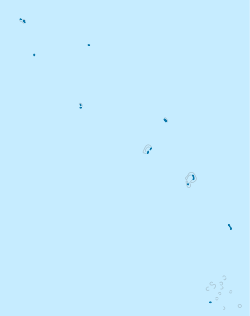Nukulaelae
| Nukulaelae | |
|---|---|
| Atoll | |

Nukulaelae atoll from space
|
|
| Location in Tuvalu | |
| Coordinates: 09°22′12″S 179°48′31″E / 9.37000°S 179.80861°ECoordinates: 09°22′12″S 179°48′31″E / 9.37000°S 179.80861°E | |
| Country | Tuvalu |
| Population (2012) | |
| • Total | 324 |
| ISO 3166 code | TV-NKL |
Nukulaelae is an atoll that is part of the nation of Tuvalu, and has a population of 324 (2012 census) the largest settlement is Pepesala on Fangaua islet with a population of 247 people (2012 census). It has the form of an oval and consists of at least 15 islets. The inhabited islet is Fangaua, which is 1.5 kilometres long and 50 to 200 meters wide. The easternmost point of Tuvalu is Niuoko islet. The Nukulaelae Conservation Area covers the eastern end of the lagoon. A baseline survey of marine life in the conservation zone was conducted in 2010.
The junior school is Faikimua Primary School.
The traditional history of Nukulaelae is that a white-skinned man was the first person to sight the island, but he did not settle as there were no trees. Nukulaelae means 'the land of sands'. Later, according to tradition, Valoa from Vaitupu discovered Nukulaelae while on a fishing expedition. He returned to Nukulaelae and planted coconut trees and eventually settled on Nukulaelae with his family. On the islet of Tumuiloto was a malae named Fagafale where religious rights honouring ancestral spirits were practiced. On the islet of Niuoka is a large stone at a place called Te Faleatua - 'the house of the gods.'
In 1821 Nukulaelae was visited by Captain George Barrett of the Nantucket whaler Independence II He named the atoll ‘Mitchell’s Group’.
Christianity first came to Tuvalu in 1861 when Elekana, a deacon of a Congregational church in Manihiki, Cook Islands became caught in a storm and drifted for 8 weeks before landing at Nukulaelae on the 10th of May 1861.
The population of Nukulaelae in 1860 is estimated to be 300 people. For less than a year between 1862–63, Peruvian ships, engaged in what became to be called the "blackbirding" trade, came to the islands seeking recruits to fill the extreme labour shortage in Peru, including workers to mine the guano deposits on the Chincha Islands. While some islander were voluntary recruits the "blackbirders" were notorious for enticing islanders on to ships with tricks, such as pretending to be Christian missionaries. About 200 were taken from Nukulaelae as immediately after 1863 there were fewer than 100 of the 300 recorded in 1861 as living on Nukulaelae.
...
Wikipedia

